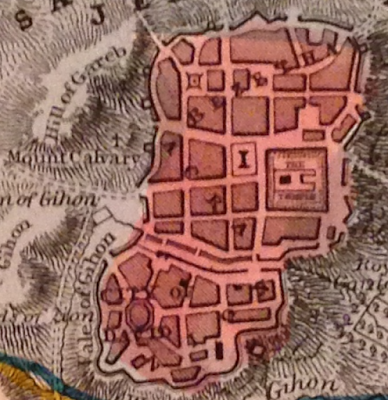I bought this map of Jerusalem at M. Pollak's map store in Tel Aviv. I really like this one and was very excited to buy it.
The map is titled "Land of Moriah or Environs of Jerusalem". The map maker is Thomas Starling, and printed at the bottom is "London, Published for the proprietors. by Mr. Bull, Holles Street Cavendish Square". An inscription on the back from the seller indicates that the original date of publication was 1836. This date, however, does not appear on the map itself.
That's about all I know about the map. Research shows that Starling published a few atlases, including some in the U.S., but I can't figure out which one this would be from.
What I can point out are some of the really unique features of this map, starting with the name, Land of Moriah. The name alone is controversial as it's a biblical name about which scholars disagree. Some say that it refers only to the site in Jerusalem where the Temple of Solomon stood, while others say it may refer to a region, as shown on this map. There are differences based on religious belief as well.
The map is interesting as it shows how the land would have been divided between at least two of the 12 tribes of Israel, here, Judah is in the south and Benjamin in the north. It also has a great little plan of old Jerusalem with certain important sites pointed out.
To really get an appreciation for some of the more interesting details on this small map, one needs to look much more closely.
For example, there's a tiny cross on the Mount Calvary. A structure is simply identified as "the temple" and "the City of David" all appear in the small plan of Jerusalem.
The map also notes the site of at least two biblical battles between the Israelites and the Ammonites and the Philistines.

Bethlehem, and the road between it and Jerusalem are shown on the map, alongside "David's Cistern" and "Solomon's Fountains". All of these, are, of course, biblical sites.
 There is also reference to sites of "idol worship" and a number of other specific places found in biblical reference.
There is also reference to sites of "idol worship" and a number of other specific places found in biblical reference. This is a small, but attractive map that is meant to show not only a biblical history, but may also reflect an interest in such matters at the time. The effort that went into making such a map, must have some positive correlation to the contemporary demand for such a product.
This is a small, but attractive map that is meant to show not only a biblical history, but may also reflect an interest in such matters at the time. The effort that went into making such a map, must have some positive correlation to the contemporary demand for such a product.I only wish I knew a bit more about this map and its origins, and I welcome insights from those who know more about this publisher and this cartographer than I do.




No comments:
Post a Comment